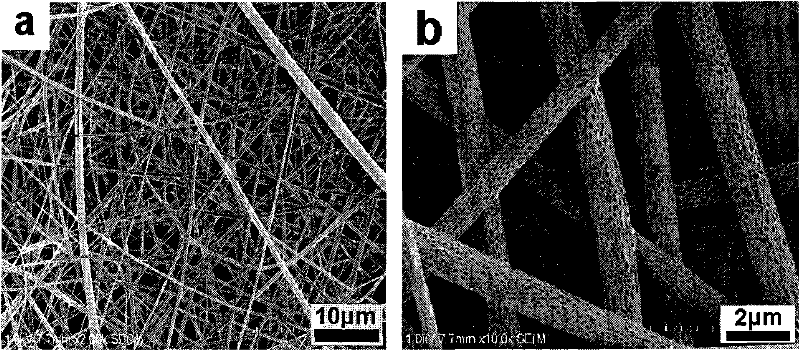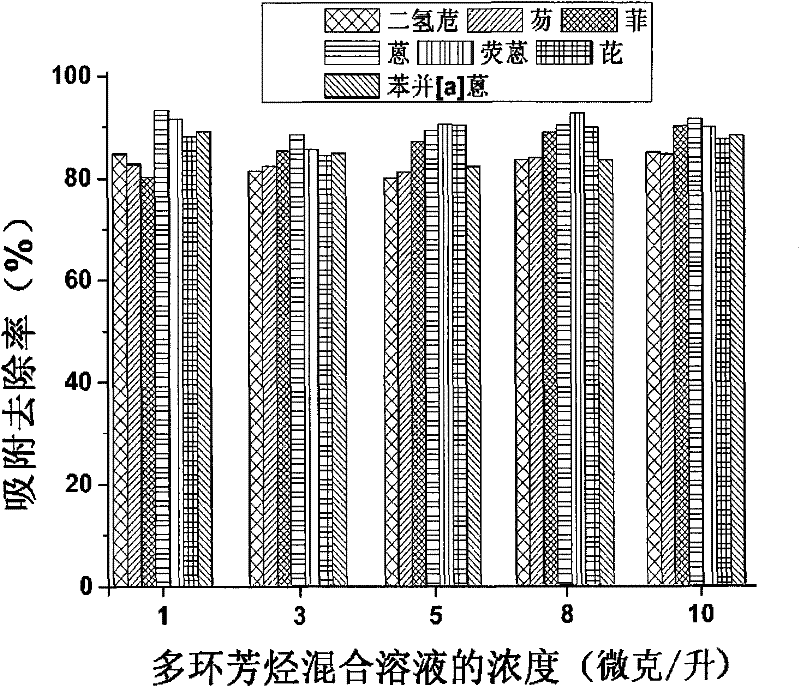Method for removing trace polycyclic aromatic hydrocarbon from water through quick adsorption
A technology for polycyclic aromatic hydrocarbons and water removal, applied in the direction of adsorption water/sewage treatment, chemical instruments and methods, water/sewage treatment, etc., can solve problems such as poor performance of organic matter, and achieve strong adsorption capacity, mild conditions, and simple operation Effect
- Summary
- Abstract
- Description
- Claims
- Application Information
AI Technical Summary
Problems solved by technology
Method used
Image
Examples
preparation example Construction
[0032] The preparation steps of electrospun nanofiber membrane include:
[0033] 1) Dissolve polylactic acid-caprolactone co(P(LA / CL), 7 / 3) particles with a molecular weight of 100,000 in dichloromethane, and add block copolymer surfactants to optimize spinning performance. After uniformly mixing, stirring for 2 hours to obtain a mixed gel, wherein the amount of block copolymer F108 is 17% of the weight of polylactic acid-caprolactone (P(LA / CL), 7 / 3);
[0034] 2) The high-voltage electrostatic spinning equipment is composed of a DC high-voltage power supply, a spinneret and a receiving device. The mixed gel obtained in step 1) is introduced into a high-voltage electrostatic spinning device, the power supply voltage is adjusted to 10 kV, and the receiving distance is 15 cm to obtain a stable and continuous jet. Irradiate with infrared light during the whole spinning process to make methylene chloride completely volatilize;
[0035] 3) Collect the electrospun fiber membrane on the al...
Embodiment 1
[0046] 1.2 grams of polylactic acid-caprolactone (P(LA / CL), 7 / 3) was dissolved in 20 grams of dichloromethane, and then 0.2 grams of block copolymer surfactant F108 was added, mixed evenly and stirred for 2 hours to obtain the mixture gel. Then the mixed gel is introduced into the high-voltage electrostatic spinning device to be spun. The high-voltage power supply voltage is adjusted to 10 kV and the receiving distance is 15 cm to obtain a stable and continuous jet flow, and the fiber products are collected on the receiving plate covered with aluminum foil paper. In the whole spinning process, infrared lamp is used to evaporate the methylene chloride completely. After 4 to 5 hours, when the thickness of the fiber membrane reaches 0.3-0.5 mm, the spinning is stopped to obtain a polylactic acid-caprolactone (P(LA / CL), 7 / 3) electrospun nanofiber membrane. The polylactic acid-caprolactone (P(LA / CL), 7 / 3) electrospun nanofiber membrane was subjected to fiber morphology characteriz...
Embodiment 2
[0049] The preparation steps of the electrospun nanofiber membrane are the same as in Example 1.
[0050] The obtained polylactic acid-caprolactone (P(LA / CL), 7 / 3) electrospun nanofiber membrane was cut into small squares of 1.5 cm×1.5 cm and peeled off from the aluminum foil. Then weigh 0.1 g (about 5 pieces) of electrospun nanofiber membrane and add it to 50 ml of 7 polycyclic aromatic hydrocarbon mixed solutions with a concentration of 3 μg / L; and place the mixed system at 30°C and 120 revolutions / min. After 20 minutes of reaction, samples were taken and measured by high performance liquid chromatography (DIONEX U3000, USA). The adsorption removal rate of 7 kinds of polycyclic aromatic hydrocarbons by this method were: acenaphthene 82.4%, fluorene 82.6%, phenanthrene 85.5%, Anthracene 88.6%, fluoranthene 85.6%, pyrene 84.4%, and benzo[a]anthracene 84.9%.
PUM
| Property | Measurement | Unit |
|---|---|---|
| diameter | aaaaa | aaaaa |
Abstract
Description
Claims
Application Information
 Login to View More
Login to View More - R&D
- Intellectual Property
- Life Sciences
- Materials
- Tech Scout
- Unparalleled Data Quality
- Higher Quality Content
- 60% Fewer Hallucinations
Browse by: Latest US Patents, China's latest patents, Technical Efficacy Thesaurus, Application Domain, Technology Topic, Popular Technical Reports.
© 2025 PatSnap. All rights reserved.Legal|Privacy policy|Modern Slavery Act Transparency Statement|Sitemap|About US| Contact US: help@patsnap.com



